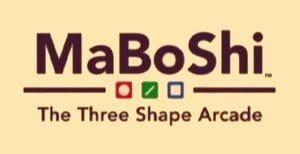
However upon playing it following its release in late August all our reservations were swept aside and it was promptly awarded an 8/10 in our review. We wanted to know more about how this intriguing game came to pass so we set about contacting the Japanese developers at Mindware Corp. to find out more.
Thankfully Micky G. Albert the president of Mindware Corp. in Japan was in the mood for sharing so here in the first of a two part series is our exclusive WiiWare World interview. We hope you enjoy!
WiiWare World: Can you tell us a little about Mindware's journey as a company?
Micky G. Albert: In Febuary 1988, the end of 8-bit PC era, I founded MNM Software. I was in the second year of high school.
Around the time I was seeing more and more games focusing on "more and bigger." But I was against the trend. I thought:
- We can't continue faking qualitative change just by adding more and more contents. Players will see the truth in time, and they will get bored of such games.
- Striving for more and bigger won't make people happy.
Have you ever heard of this Japanese word: Karōshi? It means "death from overwork." I had to witness such cases. Shocking events for a high school boy to face, don't you think? I knew without improving the work environment, these things would happen again and again. However, people around me did nothing to stop it, and crammed employees with more works.

In the end, I made a company myself. This was mainly because I couldn't find any other company that would try to change the situation.
From 1988 to May 1993, we released several dozens of titles, including Star Wars Attack On The Death Star, Slap Fight MD, and Street of Rage. In 1992 I got seriously ill. The doctor even told me that my days were numbered. I had to close the office in May 1993, because I could not leave my bed any more.
Fortunately, I could recover from the illness in Febuary 1995. This illness made me think. I discussed lots of things with my best friends about why we continue making games and where we should be going. At that time, I changed the company name to "Mindware."
Since then we made several PC games. We licensed our product for mobile phones, too. (Twinkle Harmony for NOKIA)
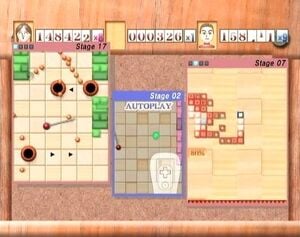
In late 1995, we started our research for "developing the most fun PC Pinball game in the world." To do so, we felt that we needed to know every pinball machines, any type, old and new, from any company. So we collected many machines. As we repaired them (there were about 40), our friends started telling us "Hey, we'll pay you, so let me play these pinballs!" So we began to lease our pinball machines. We still do pinball leasing to this day.
Our direction, "More fun, not bigger" and "Do not rely on quantity" (you can't make players happy just by adding more and more things), remained the same... Well, I have to say we got even more radical since we changed our name to Mindware. The market was going to the opposite direction. Games were getting more and bigger, but not much fun. We lurked and continued our research for "Games with true qualitative changes" to prepare for the new era of gaming to come some day.
In 2005, we felt we were ready to present our titles, so we contacted Nintendo. This was how the development of MaBoShi started.

WW: What is the story behind MaBoShi? Is Mr. Maboshi based on someone in particular?
MA: We should talk about Maboshi-kun (Mr. Maboshi) first.
His name came from MAru(Circle), BOu(Bar), SHIkaku(square) - the main three shapes in this game. Late in development, we got feedbacks that the effect system was not easy to understand. So we needed to create something that can show the system intuitively. The result was what is now known as Mr. Maboshi mode.
It's there so that players can experience the power of the effect system. It also serves as a surprise event, so I think the mode has more presence in the final game.
There was a robot character in the mode. I named him Maboshi. The naming went like this. I asked one of our staff that "Hey, how about naming him Maboshi-kun?" His reply was "Absolutely NOT!" So I asked him again. "Then how would you name him?" He told me, "Something other than Maboshi-kun!" At this point, I got a bit stubborn. I kept calling the character Maboshi-kun. After a while everyone in the team regarded the name as the final one.
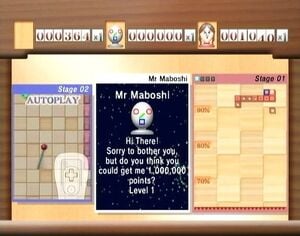
Anyway no one expected that his name would become the title of the game. We were very surprised when we were told "The game title in EU is MaBoShi!"
He has such a distinct primitive look because we wanted to show that he is not a usual Mii. So his face is not based on someone in particular.
WW: Having three games in one is a novel concept, what were the influences behind each game?
MA: I once wrote an article about game design document writing. The first things I wrote were:
- Do not describe your game by using some other popular/well-known title names.
- You should explain the game first. Do not start the document from the story and characters.
Our focus always has been unique game concepts. We highly value originality. So we rarely draw our inspiration from other videogames.
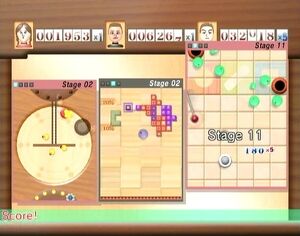
Well, I can say we get inspiration from something other than videogames. Since we started working on pinball tables, we realized that software development usually happens in very closed space. I think it's hard to come up with new and fresh ideas if you just keep sitting in front of your PCs.
Working on pinball tables has given us new perspectives. Leasing the tables and directly interacting with our customers (sometimes a drunk guy in the bar gave us sharp but truthful remarks) have taught us lots about how retailers and players would see things.
When we work on game ideas, we usually try to find their minimal cores first. This means we boil down the ideas to the point where we can't take anything out. This approach is very useful in creating something really new. We always try to create totally new games, and we used the approach in developing MaBoShi.
WW: Which game do you think will be most popular with gamers?
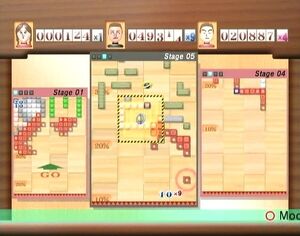
MA: I assume if you play MaBoShi through and through, the bar game would become your favourite in the end.
We put the circle on leftmost side, so most people start playing it first and would love its simplicity. Later people try and might fall in love with the bar or the square.
I think people are into action games / shoot-em up games would find the bar as their favourite, and puzzle game lovers would enjoy the square the most. Some might go back to the circle after playing bar/square. The circle is so simple and elegant after all.
All of the three games are so simple but deep. I think it's important for game designers to realize that simplicity and depth can co-exist.
The square is a bit special among the three. You can directly control your character using the D-Pad, and it's turn-based. You can wait as much as you like. We designed it so because we wanted to have something for people who can't enjoy real-time gameplay at all.
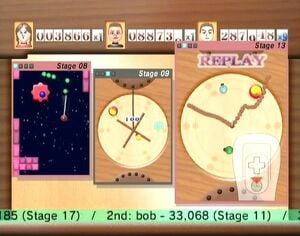
WW: Is MaBoShi targeted at casual or hardcore gamers?
MA: Our target is: Everyone. We always make our games for everyone so that they can understand them and have fun.
When you develop a truly new and innovative game, that new and innovative element might hinder players' understanding because it's new! I think "The game had something new and innovative, but players could not understand it" is like a "Did Not Finish" in a race. This is worse than "Did finish in last place."
So we tried to make our game both innovative and easy to get into.
Our ideal is making our game just right for everyone. These days it's rare to see nice level designs in games that can entertain players with various skill levels. Sometimes, designers would separate gamers from the start, saying this game is for hardcore, or that game is for casual. They might also provide several difficulty settings. Do these make their games really more accessible? I doubt it. I think what we need to do is designing something everyone would think is fair and challenging enough, not dividing gamers into smaller groups by their skills or interests.
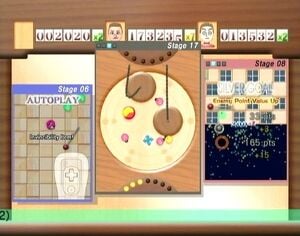
WW: MaBoShi only uses D-pad and the action button for the control scheme. Were you not tempted to make use of the Wii Remote's motion sensing abilities in some way?
MA: No, not at all. We had "one button control" idea from the beginning. We do think the motion sensing is one of the distinct features of Wii. See Wii Sports. I still enjoy playing it with my wife. But then it's easy to expect many Wii titles would make players swing their Wii Remotes.
We wanted to make MaBoShi stand out by not using "swing and play" controls. Well, VC titles are not using motion sensing abilities, so we wanted to push the concept even further to make MaBoShi even more distinct. Wii Sports is a "Play and sweat" title. We designed MaBoShi to be the extreme opposite. We wanted it to have "simple and minimal" control so that even a drunk and tired guy lying on a couch can play. This simple control concept and our "building up a game from its minimal core" philosophy went hand-in-hand.
Update: You can now read part 2 of our exclusive MaBoShi interview!

Comments 18
Mr. Albert: Our direction, "More fun, not bigger" and "Do not rely on quantity" (you can't make players happy just by adding more and more things), remained the same...
Plättchen could serve as an example of a game that had a lot but was not as fun.
I definitely agree with you on that one, Marky.
I'm very much looking forward to the NA release of MaBoShi.
Pretty cool that MaBoShi is coming to the NA region. I think it'll be more successful Nintendo game than Magnetica Twist was. Can't wait to see if Mindware will make another WiiWare game in the distant future.
Great interview!
MarkyVgoroth you're so right; I was thinking that maybe Bplus needs to learn some things from Mindware.
Anyway, I hope MaBoShi gets here soon.
That was a really great interview. Now I can't wait for the next part.
Great interview. I'm so excited for this to come to NA. MaBoShi is gonna be sweet!!
Nice interview! Can't wait for it to come out in the US.
Nice! I really like this guy's philosophy about game design, it matches up really nicely with Nintendo's dedication to "gameplay and not graphics".
I can't wait for this to come to america... Bomberman Blast first.. of course =p
Awesome interview, still one of my favourite WiiWare games
Great interview. I can't wait for this to come to NA!
Boy, Mickey G likes to talk!
Great interview. When is NA getting it?!? Waaaaaant!!!
Cant wait!!... hope it comes out soon maybe next week or next month on October!
It's been a while since we've gotten an interview...nice job, Team WWW!
Very interesting interview. Now when's NA gonna get this game?
For something like WiiWare, I can understand, but sometimes... great games just go by way too fast. Interview was great! Finally, someone who went a bit more in depth than "This is what the game does and it is fun." Eagerly awaiting for Part Two!
lockelocke-san: "Nice! I really like this guy's philosophy about game design, it matches up really nicely with Nintendo's dedication to 'gameplay and not graphics'."
As this game proves, you do not have to choose one and neglect the other (bad graphics-goog gameplay; good graphic-bad gameplay); this game looks rather nice in graphics.
TopHatPangolin-san, is your avatar of Klonoa?
Show Comments
Leave A Comment
Hold on there, you need to login to post a comment...